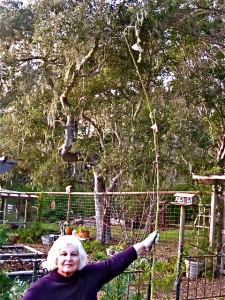“God made rainy days, so gardeners could get their housework done.”

I haven’t been doing much gardening this month. Why? First, in rained over 10 inches in late December and we were spending our time getting the rain to drain through our garden and on down the hill. We live on a slight downslope. The water from the hill behind our property was gushing from gopher holes like artesian springs. I’m not ashamed to say that I hope some gophers moved to higher ground (heaven) or were washed out to sea. That sounds like the stuff of a great children’s story!
During the heaviest rain, I had to make a little furrow through the chicken coop to get the water to drain out. Poor chickens.They were wading in murky water for a couple of days before I figured out what to do to get the water to go on by. During this time our dear little hen “Rosie” died (see Hen Talk Blog). I appears that she had an infection in her “egg maker” and we were so distracted by the downpours we didn’t notice that she was suffering. She died in my arms as I was preparing medicine for her. This has been a hard thing for me because I think that had I realized she was ill sooner, I could have saved her.
When the sun came out we started our pruning tasks. First we attacked our Pittosporum shrubs, then went on to the smaller fruit trees. Next come the roses and perennials. With the beautiful sunshine, the fruit trees think it is spring and are already beginning to blossom. This is not good. If the apple trees bloom too early, the flowers may be washed off by a winter storm. Whoa girls…..slow down. Take it easy. It’s only mid January.
I had to get this picture of the last hollyhock of the season. This was a volunteer plant (from last year’s hollyhock) that came up and grew, and grew, and grew…….. It had pale pink petals with a serrated edge). Hollyhocks do well here along the coast but they get something called “hollyhock rust” on the leaves. This causes them to shrivel and to become quite ugly. But the flower stalk continues to grow and bloom for 6 months. The seeds of this hollyhock were pocketed from the debris box of Hearst Castle when I worked as a volunteer in the garden. The Castle gardeners are working on finding and planting the varieties of flowers that were part of the original landscape design of the 1930’s. I wonder if this hollyhock was one of Mr. Hearst favorites?


